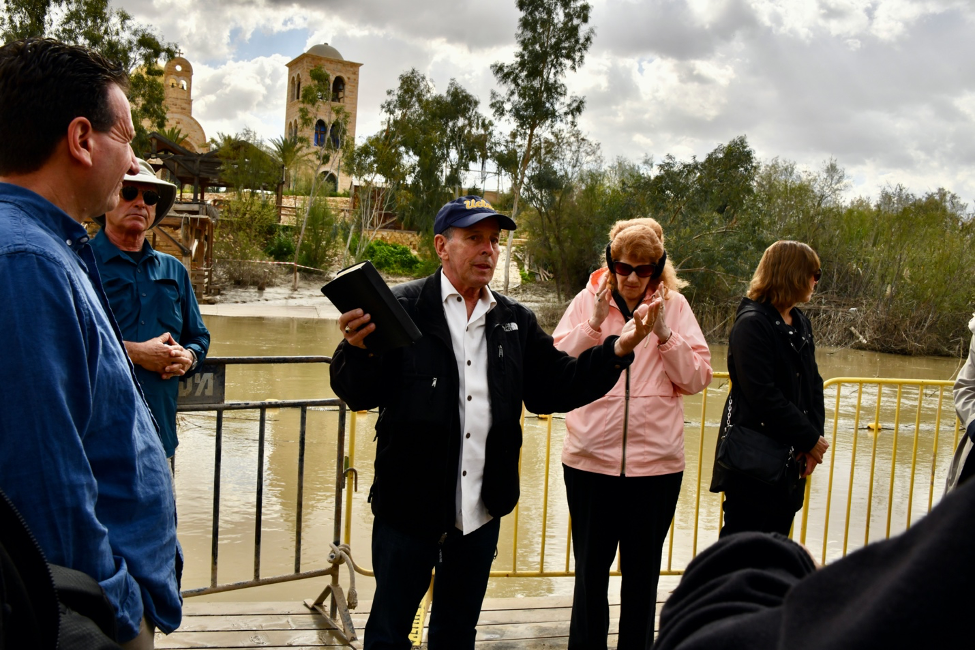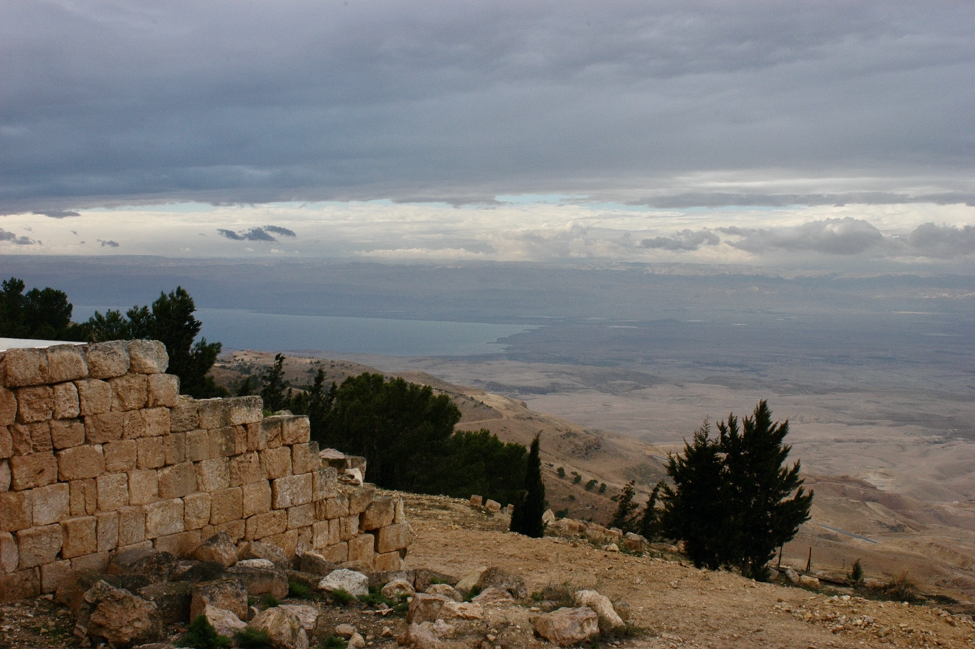Teaching Tour
Jordan and Egypt 2022
1: Bethany beyond the Jordan
Listen to Dr. Creasy’s daily teaching as you travel.
Click to play or download to listen on the go!
Dr. C. teaching at Bethany near Jericho, on the west bank of the Jordan River in Israel.
“Bethany beyond the Jordan” is where we’re going today, across the river in Jordan where you see the church.
John baptized Jesus right here!
Photography by Ana Maria Vargas
Bethany beyond the Jordan
It’s a “full immersion” day, with a visit to the site in Jordan where three very important things happen in the bible. First, after the Exodus from Egypt and their forty years in the wilderness, the Israelites cross the Jordan River and begin their conquest of the Promised Land, attacking and destroying Jericho. We read in scripture that when the priests carrying the Ark of the Covenant stepped in the Jordan River it stopped flowing and its waters piled up in a heap, while the people crossed over the Jordan on dry ground (Joshua 3: 16).
Second, leaving Jericho (in Israel), the prophet Elijah struck the Jordan River with his rolled up cloak, the water stopped flowing upstream and both Elijah and Elisha crossed over on dry ground. Once on the Jordanian side of the river, a chariot and horses of fire swooped down, scooped up Elijah and took him to heaven in a whirlwind (2 Kings 2: 8, 11).
Finally, John the Baptist baptized Jesus at this very spot at “Bethany beyond the Jordan,” right where you will be standing this morning (Mark 1: 9-14). How cool is that!
Mount Nebo
View of the Holy Land from Mount Nebo, the northern tip of the Dead Sea at top left.
Photography by Ana Maria Vargas
Moses stood at this very spot and looked over into the Promised Land, but God did not permit him to cross the Jordan River to enter it. Moses had climbed up the mountain, took one good look then walked further on and died . . . and no one knows where he is buried (Deuteronomy 34: 1-5).
Perhaps we’ll find his grave as we poke around and explore the “mountains of Moab!”
Machaerus
Caravaggio. Salome with the Head of John the Baptist (oil on canvas), c. 1610.
National Gallery, London.
I am so envious of all of you! I was really looking forward to this. Although I’ve been to Jordan many times, I’ve never visited Machaerus, the site of John the Baptist’s beheading. I’ve read the story in the Gospels (Matthew 14: 1-12); I’ve seen two versions of Caravaggio’s painting, one at the National Gallery in London (above) and another at the Prado in Madrid; I’ve seen Oscar Wilde’s 1896 one-act play Salome; and I’ve attended Richard Strauss’s 1905 opera Salome at both the Metropolitan Opera in New York and at the San Diego Opera here in San Diego. But I’ve never been to the actual archaeological site of John’s beheading.
You’ve topped me with this one!
2: Petra
Listen to Dr. Creasy’s daily teaching as you travel.
Click to play or download to listen on the go!
Emerging from the ¾-mile-long Siq in Petra, approaching the Treasury Building façade. This is the setting for the end of Indiana Jones and the Last Crusade.
Photography by Ana Maria Vargas
“Petra” is from the Greek Pevtra, meaning “Rock.” And “rocks” there surely are! The entire city is built and carved out of beautiful red sandstone rock, the site being famous for its cut-rock architecture and its ingenious water conduit system. Today, Petra is a UNESCO World Heritage Site, called by UNESCO “one of the most precious properties of man’s cultural heritage.” In 2007 Petra was voted one of the “New Seven Wonders of the World,” and I and my Logos students had the privilege of casting our “yes” vote while visiting Petra at that time!
Dr. C. and his son, Adam, posing before the beautiful striated red rock of Petra.
Pray that it rains while you’re in Petra, for when it rains the red rocks pop into bold, brilliant colors!
Photography by Ana Maria Vargas
Pliny the Elder (A.D. 23/24 – 79) identified Petra as the capital of the Nabataean Kingdom. In New Testament times it was a client state of the Roman Empire. Due to its location on the major land trade routes and its natural fortress-like construction, Petra became a financial center for international commerce, the “Swiss bank” of its day. In A.D. 106 Petra lost its independence, however, when the Roman Empire annexed it. Over time Petra declined as sea trade routes eclipsed the land routes, and in A.D. 363 a massive earthquake destroyed much of the city.
Our first-century historian Josephus (A.D. 37 – 100) writes in his Antiquities that in Moses’ day the Midianites occupied the region of Petra and that Moses allocated their land to the tribe of Reuben (Joshua 13: 15-23). In addition, we read in Numbers that the Israelites “fought against Midian, as the Lord commanded Moses, and killed every man. Among their victims were Evi, Rekem, Zur, Hur and Reba—the five kings of Midian. They also killed Balaam son of Beor with the sword. The Israelites captured the Midianite women and children and took all the Midianite herds, flocks and goods as plunder” (31: 7).
Remember the story of Balaam and his talking Ass (Numbers 22: 1-? That story took place here.
Rembrandt. Balaam and His Ass (oil on oak), 1626.
Musée Cognacq-Jay, Paris.
Here’s my version of the Balaam story:
On our “Footsteps of St. Paul” in Cappadocia, Turkey, this little guy spoke to me plainly and said:
“How about giving me some of those peanuts in your coat pocket!”
Photography by Ana Maria Vargas
In Old Testament times Petra was within the territory of Edom. Recall that the Edomites were descendants of Jacob’s twin brother, Esau. “Edom” means “red,” like the color of Esau’s hair. Jacob and his twin brother Esau struggled with each other, even in Rebekah’s womb. Jacob—the deceiver—cheated his brother over and over again, finally stealing Esau’s birthright as the elder of the twins. Esau vowed revenge, thinking: “The days of mourning for my father are near; then I will kill my brother Jacob” (Genesis 27: 41).
What began as a struggle between two boys in their mother’s womb ballooned into the struggle between two nations, Israel and Edom. When the Babylonians laid siege to Jerusalem in 588-586 B.C., the city collapsed . . . and it was the Edomites, along with the Babylonians, who sacked it. Listen to Psalm 137, the voice of those survivors taken captive to Babylon:
By the waters of Babylon there we sat and wept
when we remembered Zion.
There on the poplars
we hung our harps,
for there our captors asked us for songs,
our tormentors demanded songs of joy;
they said, “Sing us one of the songs of Zion!”
How can we sing the songs of the Lord
while in a foreign land?
If I forget you, Jerusalem,
may my right hand wither.
May my tongue cling to the roof of my mouth
if I do not remember you,
if I do not consider Jerusalem
my highest joy.
Remember, Lord, what the Edomites did
on the day Jerusalem fell.
“Tear it down,” they cried,
“tear it down to its foundations!”
Daughter Babylon, doomed to destruction,
happy is the one who repays you
according to what you have done to us.
Happy is the one who seizes your infants
and dashes them against the rocks.
Edom was also the target of a dreadful prophecy in the book of Obadiah:
This is what the Sovereign Lord says about Edom—
We have heard a message from the Lord:
An envoy was sent to the nations to say,
“Rise, let us go against her for battle”—
“Look! I will make you small among the nations;
you will be utterly despised.
The pride of your heart has deceived you,
you who live in the clefts of the rocks
and make your home on the heights,
you who say to yourself,
‘Who can bring me down to the ground?’
Though you soar like the eagle
and make your nest among the stars,
from there I will bring you down,”
declares the Lord.
So, there’s something to think about while you’re exploring Petra!







